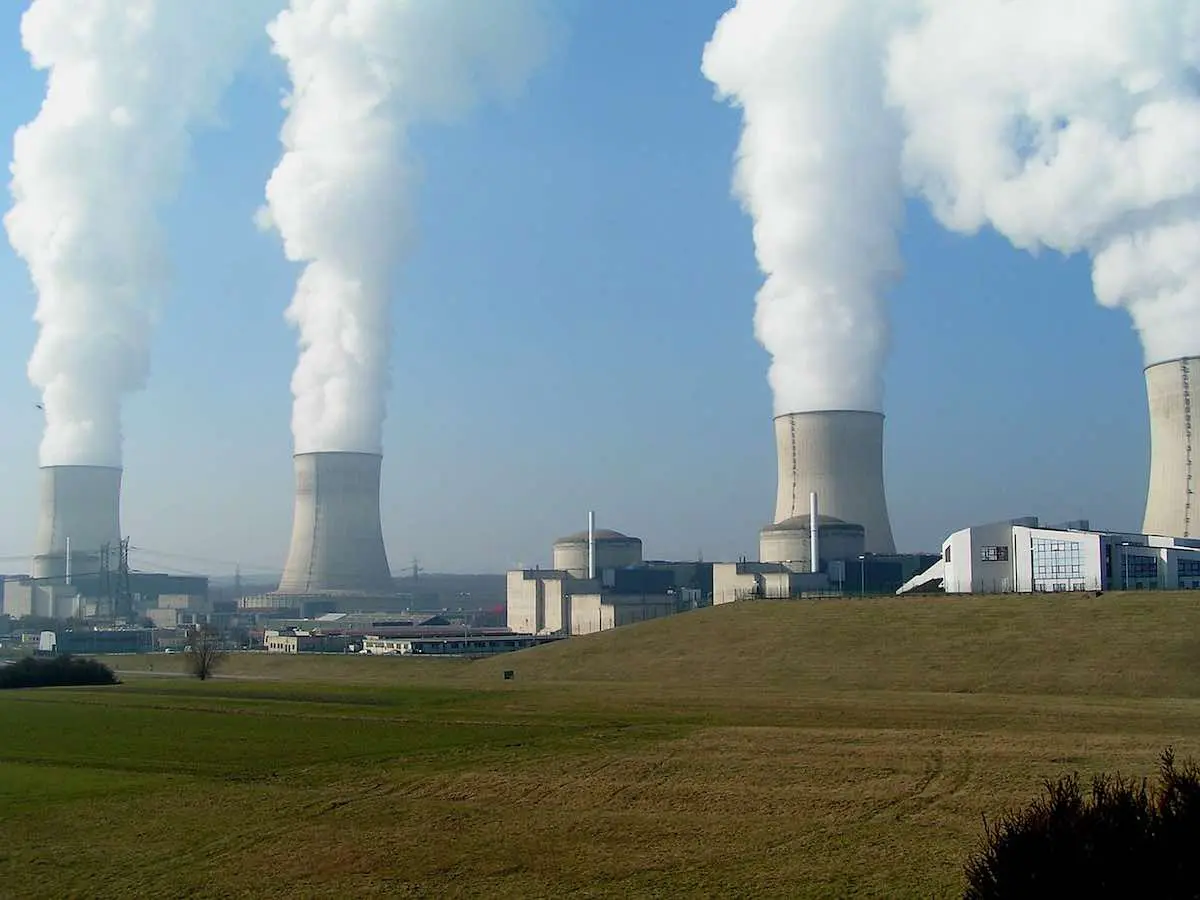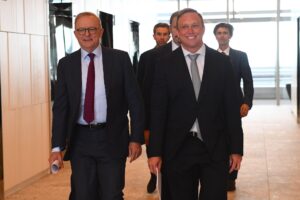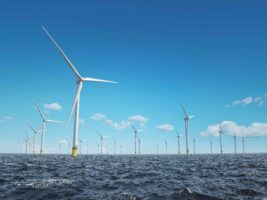Federal opposition leader Peter Dutton will take nuclear energy to the next election, telling a business conference in Sydney on Tuesday that the Coalition is preparing to reveal “potential host sites” for six nuclear power plants around the country.
In a mess of metaphors and big words, Dutton told the Australian Financial Review’s business summit he wants the “scientific facts” on the table – not about climate change, mind – as well as an alternative to federal Labor’s “all-eggs-in-one basket” and “utterly reckless” energy policy approach.
“We are on the trajectory to immiserating our economy and impoverishing future generations of Australians under Labor’s renewables-only energy policy,” Dutton told the summit, before laying out his own uncosted and entirely hypothetical plan.
“First and foremost, we want to get the highest yield of energy using the smallest amount of land,” he said, borrowing wording from the nuclear industry’s playbook. “We want to maximise the amount of energy we can obtain per square metre and minimise our environmental footprint.”
According to the AFR, this will involve putting reactors on or near the sites of old coal-fired power stations so as the use the existing transmission grid. But much of this real estate has already been snapped up to host big batteries, which owners of old coal plants plan to use to help drive the shift to renewables.
Dutton says the Coalition plan will combine rooftop solar, gas and nuclear, and will involve offering incentives to communities to adopt nuclear power and will put people at the centre of its energy policy by making lower energy bills a key consideration.
He then doubled-triple dared federal Labor to do something the Coalition did not do in its 10-years in government and lift the ban on nuclear power and let the market decide.
Can he get an amen?!
Not really. At the same summit, Dutton’s vision of a nuclear powered Australia failed to rally much support, while those who were asked directly, like former Energy Security Board chair Kerry Schott, said the Coalition policy just doesn’t make sense, particularly if cost of living and lower energy bills are a consideration.
“Nuclear by far, like daylight by far, [is] the most expensive,” said Schott, who is currently the chair of the Carbon Market Institute.
“It really doesn’t make sense for Australia because we have so much renewable energy resources.”
The head of energy at Fortescue Metals, owned by Australia’s richest man, Andrew Forrest, was equally skeptical.
“Personally, I don’t think nuclear is the solution,” Hutchinson said. “We have abundant opportunity for renewable energy and that’s what we should be going after.”
Nuclear power would not help to Australia’s green hydrogen superpower plans, with Hutchinson noting that high power prices remained the main barrier to Fortescue’s progress, to date.
“If you look around the world where you can get cheap renewable power, competitive renewable power is below $US30 a megawatt hour,” he said.
“That should really be the target and particularly when you’re looking at really what will be a global market to supply green ammonia, green hydrogen. So that’s kind of the goal,” he said.
The facts about large scale nuclear costs have been laid bare by the countries struggling to build them – including the UK, France and the US – and on the small modular scale by Australia’s premier science agency, CSIRO, and the Australian Energy Market Operator.
“It (nuclear) does not currently provide an economically competitive solution in Australia. We also do not have the relevant frameworks in place for its consideration and operation within the timeframe required,” said the lead author of the GenCost report, Paul Graham in December.
“Using the standard formula for levelised costs plus the additional calculations specific to additional storage and transmission needs, wind and solar come in at an average of $112 per megawatt hour in 2023, decreasing to $82 per megawatt hour in 2030,” the report says.
“In contrast, based on the available updated cost data, SMRs come in at an average $509 per megawatt hour in 2023, decreasing to $282 in 2030. This projection shows nuclear SMR capital costs are almost half from today, but still well above the projected costs for wind and solar.”
More inconvenient “science facts” have been dished out by Hugh Durrant-Whyte, the chief scientist of New South Wales who was a former chief science adviser for the British military of defence and worked in the nuclear industry as an engineer.
In a report prepared for the former state Coalition government in 2020, Durrant-Whyte had this to say:
“There are many viewpoints on the relative cost of nuclear power versus other power sources. However, as time has progressed, nuclear has become less and less cost competitive relative to almost every source – including firmed renewables.
“It is useful to look at a current example – Hinkley Point C (UK) comprises two new PWR-type reactors being delivered by EDF of France with a total capacity of 3.3GW,” he added.
“This should be the easiest of circumstances – an established (Generation II) reactor delivered by arguably the most experienced nuclear plant construction company in the world to a site that has already received two generations of nuclear plant.
“Yet the cost of these plants have recently increased to $A40bn and power will be delivered at a wholesale price of $A164 per megawatt hour. Approval for Hinkley Point C was given in 2008, construction started in 2018 and estimated completion is 2026.
“It would be naive to expect that any new reactor designs – including SMRs – in a completely new environment, like Australia, will be any cheaper or any quicker to approve and get operational.”
Dutton says renewables will have a “role to play” in a future grid, but seems intent on focusing only on rooftop solar systems.
One thing he will need to explain is how nuclear power, which relies on being “baseload” and not turned off, can fit into the grid if rooftop solar is to be expanded – as the Coalition plan. The Coalition says this will mean fewer transmission lines, but it will also mean a lot more storage, and switching off of rooftop systems.
As Simon Holmes à Court explains here, nuclear wants to supply flat, constant power. But by the time it arrives, the residual demand left over from Australia’s firmed renewables grid will be sparse and spiky.

“Yes, nuclear can theoretically work at a low level in a grid with spiky residual demand… but it’s really challenging to operate that way and it smashes the economics,” he writes.
Meanwhile, Dutton’s plan to slow renewables, prolong coal, and fill the gaps with gas would be disastrous for both the climate and the cost of living.
According to Holmes à Court, under the Coalition’s nuclear plan, by 2050 we burning 19,000 petajoules more gas, 255 megatonnes more coal, boosting emissions by 2,100 MtCO₂ and spending another $200 billion-plus more on electricity.

“To sum up… who cares whether you are pro- or anti-nuclear?,” writes Holmes à Court, who claims to be pro nuclear power “where it makes sense.”
“Put aside the culture war. There’s no conceivable world where we #nuclear could play a meaningful role before our coal power stations have all retired. …unless you want higher prices, higher emissions and blackouts.”









